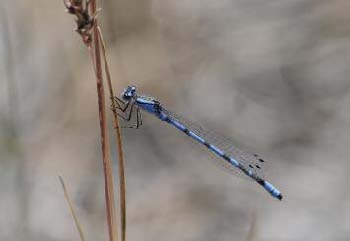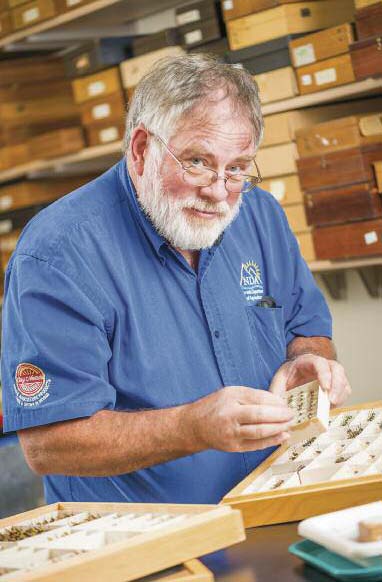feature
PONDERING POLLINATION
Nevada’s state entomologist answers questions that were bugging us.
COMPILED BY ERIN MEYERING
PHOTO BY CHRIS HOLLOMAN
Ever wonder whose dream job at 8 years old would be studying bees and bugs all day? Meet Jeff Knight, a Nevada native who achieved his dream job when he became our state entomologist.
After receiving his bachelor’s degree in pest management from the University of Nevada, Reno and his master’s degree in entomology from Utah State University, he began working as an agriculturalist for the Nevada Department of Agriculture in 1985. He has been the state entomologist since 1993.
What does being a state entomologist entail?
My role is to identify and survey native or exotic insects in Nevada. The state entomology lab serves as the state’s reference collection of all insects and other arthropods (creatures with more than six legs). Nevada agriculturists, landscapers, and residents send samples to us for identification.
I also work with our environmental scientists to develop and implement a pollinator protection plan (a resource to help improve communication around pesticide use to ensure pollinator safety in our communities). (See below for more.)
Do we have helpful native pollinators and bees (beyond the honey bee) in the Reno-Tahoe area?
Most gardens have at least a few plants that require pollination to produce fruit, and, normally, there are enough native pollinators and honey bees in the area to get the job done.
Specialists estimate there are around 1,000 to 2,500 native bee species in Nevada. Most of the bees native to Nevada are considered generalists, meaning they visit lots of different species of plants for their pollen and nectar.
A number of other types of insects also are good pollinators, such as flies, wasps, and beetles. Anything that visits the flower for nectar or pollen can be a pollinator, so this also includes many types of birds.
What can we do to avoid garden/farm pests?
Almost every plant we have in our garden or farm has at least one or more insects feeding on it that may become a problem. The NDA always encourages an integrated pest management approach, which is aimed at reducing pesticide usage. It leans on nonchemical treatments and recommends only treating pests when absolutely necessary, using the method least harmful to beneficial insects and pollinators.
Providing habitats for predators and parasites (such as small wasps and flies) can help keep pests in check. This may be as easy as planting flowers and other plant species within the growing area to provide pollen and nectar or protection. In doing this, we encourage the natural balance between pests and their predators.

What is the NDA currently doing to monitor and protect native pollinators?
The NDA’s pollinator protection plan is a voluntary plan designed to increase the communication between pest-control companies and beekeepers. We are continually adding new species to our collection and working with the USDA to further the knowledge of native bees and pollinators in Nevada.
How should people be caring for and attracting pollinators?
All insect pollinator populations increase and decrease over time (as with any insect population), and by having a diverse community of pollinators, we are not dependent on any one pollinator if its population decreases.
One of the major threats to our native pollinators is the disruption or loss of habitat. This can be partially overcome by planting areas with native plants and flowers to attract and support these pollinators. We also can provide nesting habitats, such as blocks of wood with different-sized holes drilled in them or ground nests specifically constructed to attract bumble bees .
What’s our state insect?
Our state insect is the vivid dancer damselfly (Argia vivida). They normally can be found around small streams and water sources and are considered beneficial because they eat gnats, mosquitos, and other aquatic pests.
Erin Meyering, a lover of warm weather and the outdoors, hopes to see many bees busy at work this fall. She also looks forward to seeing the state insect for the first time.


